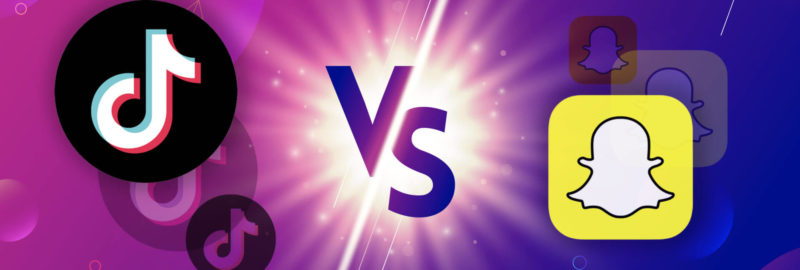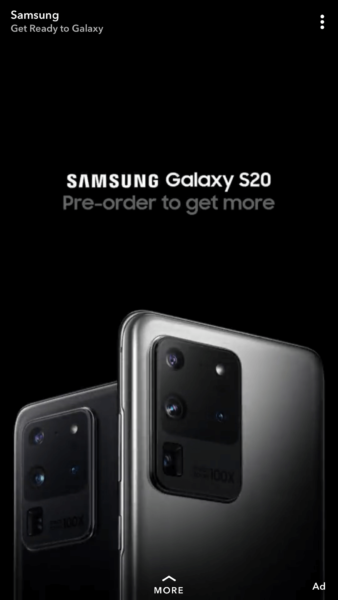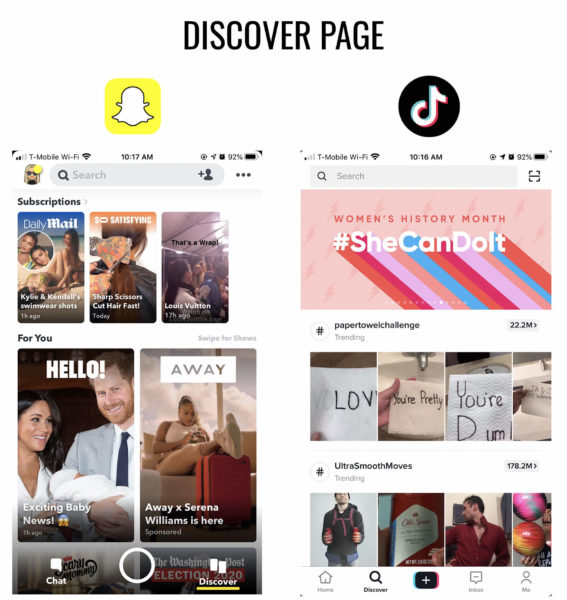TikTok vs. Snapchat: A guide for marketers
A look at the key differences between Snapchat and TikTok.

TikTok is having a moment. Whether you use the app already or have spotted TikToks popping up on other social platforms, it’s clear that TikTok isn’t just another fleeting trend. It’s here to stay.
Yet it’s easy to see how someone not familiar with TikTok (ahem, your boss) might dismiss it as a Snapchat reboot. Worse, they might assume content from Snapchat can be repurposed on TikTok.
The two platforms share similar features (and yes, similar audiences) but their value offerings are entirely different. TikTok is a video sharing app for short clips set to music while Snapchat is a photo and video messaging app centered on ‘Stories’ and other short-lived formats. Each platform offers unique ways to connect with audiences if used the right way by the right type of brand.
If you’re not sure where your brand fits in – or if it even fits in at all – you’re in the right place. Below is a simple guide that highlights key differences between TikTok and Snapchat along with essential considerations for brands looking at either app as a potential marketing channel.
At a glance…

Launched: 2011
Core features: Video and image capture, Story creation, text and video chat, camera filters, lightweight editing tools, AR ‘Lenses’, Discover tab, (Snapchat-native content covering user interests and subscriptions), Snap Maps
U.S. demographic: Primarily Millenials, with 78% of internet users aged 18-24 on the platform. Roughly 61% of Snapchat users are female and 38% are male*
Who users follow: Friends, celebrities, publishers
Daily active users: 218 million globally*
Total downloads: 75 million globally* in 2019
Revenue: $561 million in 2019*
Some brands using Snapchat: Taco Bell, Paramount Pictures, Warner Bros., Burberry, Target, MTV

Launched: 2017 in China, 2018 internationally
Core features: Video capture, powerful editing tools, filter effects, creation prompts (reactions, hashtag challenges), sound library, ‘For You’ page (TikTok’s algorithm-based discovery feed)
U.S. demographic: Primarily Gen Z. 41% of users are between ages 18-24* and 27% between 13-17. Approximately 60% of TikTok users are female; 40% are male.
Who users follow: Content creators, celebrities, brands
Daily active users: 41 million gobally*
Total downloads: 738 million globally* in 2019
Revenue: $176.9 million in 2019
Some brands using TikTok: Chipotle, E.l.f. Cosmetics, Guess, ESPN
The basics: TikTok
What it is. TikTok is a rapidly growing video-sharing app that launched in 2017 by Chinese tech company ByteDance. In October 2018, TikTok was the most downloaded app in the U.S. and reached a record 1.5 billion downloads globally at the end of 2019.
How it’s used. Users create and post short, looping videos set to TikTok’s massive library of music and sound bites – often with humor or talent as the focal point. TikTok isn’t necessarily the place for serious life updates or connecting with friends. Instead, users rely on TikTok for entertainment and follow creators with quality content. Common TikTok videos include choreographed dances, lip-syncing, hashtag challenges, reaction videos, and cringe-worthy content.
Audience. The app has rapidly become a Gen-Z favorite, with 42% of users between ages 13-16 actively using the app. Users create and post short, looping videos set to TikTok’s massive library of music and sound bites – often with humor or talent as the focal point.
Advertising. TikTok’s ad product is still in its early days. For now, advertising is only offered on a CPM basis (cost per thousand impressions) as TikTok’s self-service ad platform is still in beta. Ad units currently available include:
- In-feed native video ads
- Brand takeovers (a full-screen ad that appears when a user first opens the app)
- Hashtag challenges
- Branded filters
- Topview ads (similar to brand takeovers but uses in-feed content)
- Influencer brand partnerships
READ: TikTok 101: A primer for brands
The basics: Snapchat
What it is. Snapchat is a mobile messaging app for sharing text, photos, and videos with friends. It launched in 2011 under the premise of sharing photos with a 10-second expiration, but has since evolved to focus on ephemeral video content in the form of Stories and curated ‘Discover’ series.
How it’s used. Snapchat offers a way for users to keep up with friends, relevant news, and popular trends. A big draw is the ability to capture ephemeral content and publish it as a Story for followers to see and engage with for up to 24 hours. Snapchat has been investing heavily in AI and AR capabilities (or ‘Lenses’) to give brands and users more immersive creative abilities – like object scanning, try-on effects, and 3D environment interactions.
Audience. The platform is most popular among millennials and currently claims around 218 million daily active users (DAUs).
Advertising. Snapchat offers a range of advertising options through its self-serve ad platform, from standard Snap Ad units that appear between stories to ads that use branded filters and AR lenses. Snapchat also has an ecommerce component with shoppable ads, personalized targeting, and a native checkout feature.
READ: Marketing Land’s original guide to Snapchat
TikTok and Snapchat: Content comparison
Samsung x TikTok (sponsored challenge):
@samsung Join the Galaxy A ##danceAwesome challenge with @blackpinkofficial !
♬ original sound – Samsung
The marketing questions: Which platform is best for my brand?
What’s your objective? Both TikTok and Snapchat offer top-of-funnel opportunities for brands to connect with audiences. Specifically, TikTok can be effective for driving awareness with user-generated content (UGC) in the form of brand challenges, reactions, or filters.
While there are opportunities for brands to take advantage of UGC on Snapchat, the platform is better for sharing fleeting life moments and surfacing relevant content that the user might care about – like original series or Stories.
Plus, Snapchat’s shoppable and native checkout features can be a big draw for retail brands (especially D2C). The platform also has a hold over TikTok with more mature advertising options, while TikTok’s use for brands is still much more experimental. Don’t expect to find instant success marketing on TikTok, especially since it’s driven by users who value humor and fleeting trends (which might not work for all brands).
Consider your audience. Are they young and full of untapped meme energy? Look to TikTok. Tiktok users want a digital experience that’s authentic, homegrown, and downright entertaining. It’s part of the reason why reactions and brand challenges have taken off at warp speed. Instead of standing by and watching social play out from a distance, TikTok users are diving in head-first to leave their mark in near real-time, and brands can lean into that organic content creation process.
Since Snapchat is still a home for the Millenial generation, brands on the platform can capture more conventional, mainstream interests. As a whole, brands with audiences that skew younger should probably be experimenting with both Snapchat and TikTok.
Think about the content. If you’re focused on creating quality content with a traditional brand message, Snapchat is likely the better channel. Brands can get creative with Snapchat’s AR and Lens capabilities while still offering built-in (“swipe-up”) features for a more immersive user experience. TikTok content isn’t concerned with aesthetics or how good something looks, which makes it both a challenge and opportunity for brands. To be successful on TikTok, a brand’s content needs resonate with young users while offering the ability to engage with it.
Brand uses cases
TikTok x Chipotle Mexican Grill. Chipotle’s first viral TikTok challenge kicked off in May 2019 after a customer filmed a video doing a lid flip, which Chipotle then posted to Instagram. The post racked up over a million views, prompting the brand to turn to TikTok to invite customers to try the lid flip trick for themselves with a branded hashtag challenge. The #ChipotleLidFlip challenge received over 104 million views, 111,000 video submissions, and over 59,000 participants during the campaign.
TikTok x e.l.f. cosmetics. Makeup brand e.l.f. also found viral success with TikTok’s hashtag challenge format. With over 3 million organic views of the #elfcosmetics hashtag on Tik Tok, the brand developed its own challenge to engage with the creator-driven community. The brand commissioned a made-for-TikTok music track for its #eyeslipsface campaign, prompting users to showcase their e.l.f. makeup looks set to the song.
Snapchat x Top Gun: Maverick. In December 2019, Paramount Pictures launched an AR-driven UGC campaign with Snapchat’s Cameos feature, in which users could add creative elements to their shots with digital overlays used to promote the film. Snapchat users who were interested in seeing more promo content from the film had the option to watch the entire 2-minute trailer.
Snapchat x Coca-Cola and McDonalds. Snapchat released “Snapchat Scan” in December 2019, and McDonald’s and Coca-Cola were the first brands to jump on board. The feature offers image-recognition so users can scan logos to unlock AR lenses and content. With Coke and Mcdonalds, users simply had to scan the packaging on their food or beverage to gain access to exclusive branded lenses. It’s a key example of how brands on Snapchat can engage users by blending creative content with elements of the physical world. According to Snap’s product marketing manager Carolina Arguelles, “using Scan in this way offers so many possibilities for brands – from creating fun, shareable moments, to sharing product information or offering a virtual trial.”
Additional resources
Need a deeper dive? Check out our guides for TikTok and Snapchat below.


Contributing authors are invited to create content for MarTech and are chosen for their expertise and contribution to the martech community. Our contributors work under the oversight of the editorial staff and contributions are checked for quality and relevance to our readers. The opinions they express are their own.
Related stories
New on MarTech


